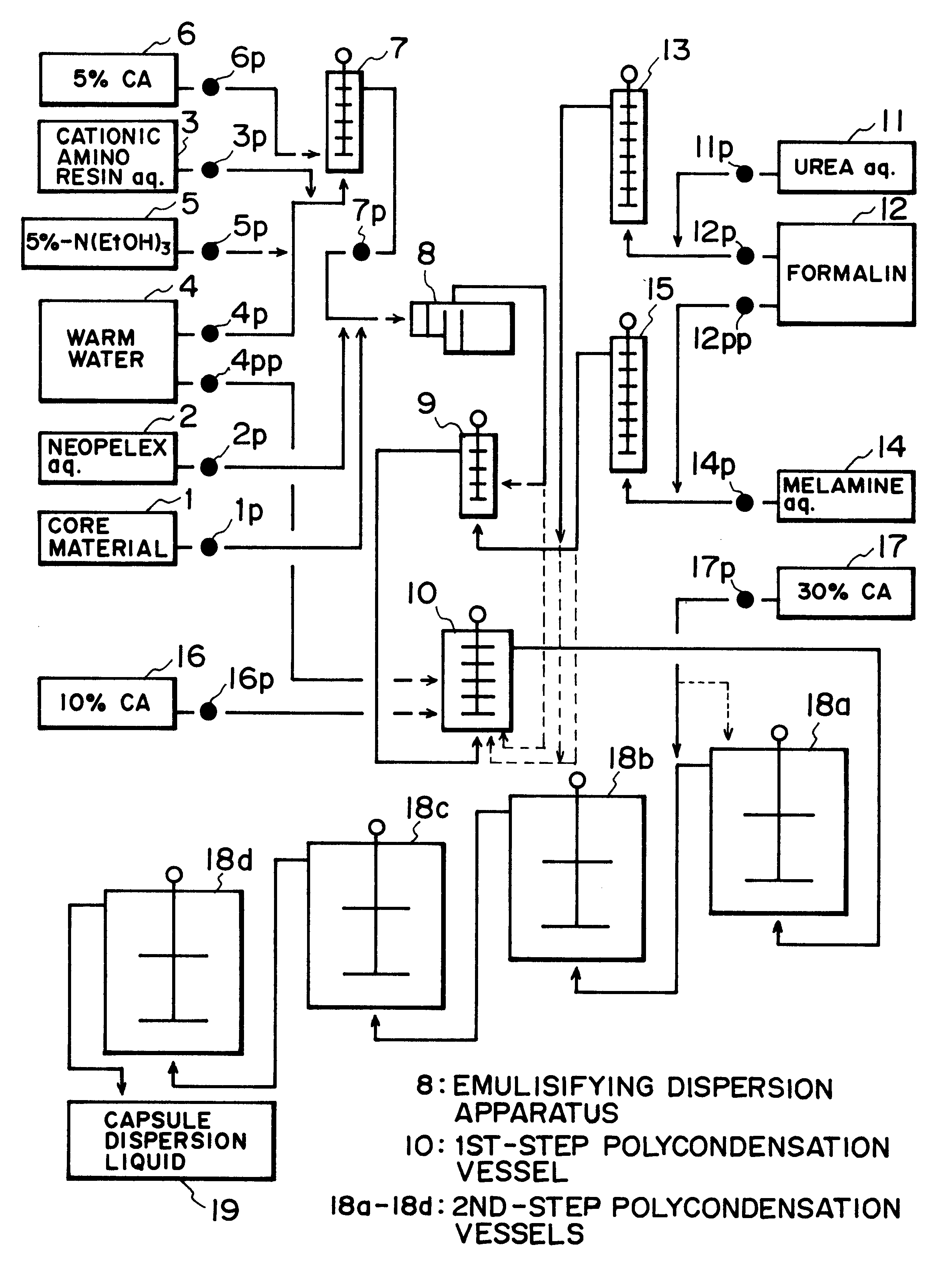Microcapsule and process for production thereof
a microcapsule and film material technology, applied in the field of microcapsules, can solve the problems of reducing the effect of core material, inability to be free from drawbacks, poor controllability of persistent chemical effect of microcapsules using gelatin as film materials,
- Summary
- Abstract
- Description
- Claims
- Application Information
AI Technical Summary
Problems solved by technology
Method used
Image
Examples
example 1
A microcapsule according to the present invention was prepared by using an apparatus system as substantially shown in FIG. 1.
(First Coating Step)
A core material (1) of chlorpyrifos (an insecticide, liquid at 45.degree. C., available under a trade name of "LENTREK" from Dow Chemical Co.) and an anionic surfactant (2) of 1% aqueous solution of sodium dodecylbenzenesulfonate ("NEOPELEX available from Kao K.K.) were provided so as to be supplied at rates of 78 kg / h and 9.0 kg / h, respectively.
Separately, warm water (at 50.degree. C.) (4) at 110 kg / h, cationic urea resin (3) ("U-RAMIN P-1500", in the form of an aqueous solution (solid content=ca. 40 wt. %), available from Mitsui Kagaku K.K.) at 7.9 kg / h and a 5%-aqueous solution of triethanolamine (N(EtOH).sub.3) (5) at 6.5 kg / h were supplied to an emulsion mother liquid mixing vessel (7) and mixed with each other therein, and then the pH of the mixture was adjusted to 4.75 by adding a 5%-citric acid (CA) aqueous solution (6) as an acid c...
example 2
Microencapsulation was performed substantially in a similar manner as in Example 1 except for the following modifications.
The first coating step was repeated except for changing the core material (1) to 60 kg / h of ethoprophos in an undiluted form ("MOCAP", an insecticide available from Rhone-Poulenc Agrochimie), and supplying 118.0 kg / h of the warm water (4), 8.3 kg / h of the water-soluble cationic urea resin (3) ("U-RAMIN P-1500") and 8.0 kg / h of the anionic surfactant (1% "NEOPELEX" aqueous solution). The preparation of the amino resin prepolymers was repeated except for supplying 19.0 kg / h of the 30%-urea aqueous solution (11) and 13.86 kg / h of the formalin (12) for preparation of urea resin prepolymer, and 30.8 kg / h of the 18%-melamine aqueous dilution (14) and 14.28 kg / h of the formalin (12) for preparation of melamine resin prepolymer. Thereafter, the first and second polycondensation reactions were repeated in the same manner as in Example 1 to complete the microencapsulation....
example 3
Microencapsulation was performed substantially in a similar manner as in Example 1 except for the following modifications.
The first coating step was repeated except for changing the core material (1) to 70.0 kg / h of carbaryl ("NAC", an insecticide available from Rhone-Poulenc Agrochimie), and supplying 118.0 kg / h of the warm water (4), 8.7 kg / h of the water-soluble cationic urea resin (3) ("U-RAMIN P-1500") and 10.0 kg / h of the anionic surfactant (1% "NEOPELEX" aqueous solution). The preparation of the amino resin prepolymers was repeated except for supplying 22.8 kg / h of the 30%-urea aqueous solution (11) and 16.6 kg / h of the formaline (12) for preparation of urea resin prepolymer, and 37.0 kg / h of the 18%-melamine aqueous dilution (14) and 17.1 kg / h of the formalin (12) for preparation of melamine resin prepolymer. Thereafter, the first and second polycondensation reactions were repeated in the same manner as in Example 1 to complete the microencapsulation.
PUM
| Property | Measurement | Unit |
|---|---|---|
| particle size | aaaaa | aaaaa |
| droplet diameter | aaaaa | aaaaa |
| droplet diameter | aaaaa | aaaaa |
Abstract
Description
Claims
Application Information
 Login to View More
Login to View More - R&D
- Intellectual Property
- Life Sciences
- Materials
- Tech Scout
- Unparalleled Data Quality
- Higher Quality Content
- 60% Fewer Hallucinations
Browse by: Latest US Patents, China's latest patents, Technical Efficacy Thesaurus, Application Domain, Technology Topic, Popular Technical Reports.
© 2025 PatSnap. All rights reserved.Legal|Privacy policy|Modern Slavery Act Transparency Statement|Sitemap|About US| Contact US: help@patsnap.com


